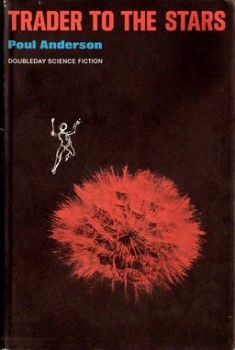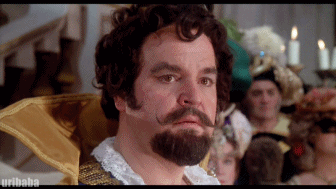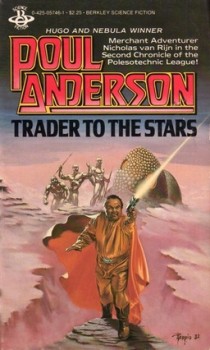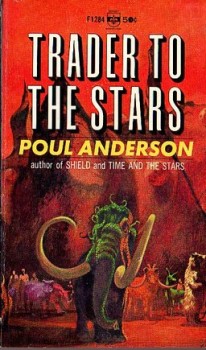Trader to the Stars by Poul Anderson
 I have no idea which Poul Anderson book I picked up first. It might have been The Winter of the World or Hrolf Kraki’s Saga. Whichever it was, I enjoyed it. It was enough to get me grabbing books at random from the big stack of his work my dad had bought. I’ve read a ton of his books, but with nearly seventy novels and sixty short story collections to his name, I still have plenty to go.
I have no idea which Poul Anderson book I picked up first. It might have been The Winter of the World or Hrolf Kraki’s Saga. Whichever it was, I enjoyed it. It was enough to get me grabbing books at random from the big stack of his work my dad had bought. I’ve read a ton of his books, but with nearly seventy novels and sixty short story collections to his name, I still have plenty to go.
I’d venture a guess that Poul Anderson, multiple Hugo- and Nebula-winner, is probably better remembered for his fantasy than for his science fiction. Since his death in 2001, it seems his fantasy writing, the seminal swords & sorcery novel The Broken Sword in particular, has acquired a much greater reputation than his sci-fi.
While he wrote many standalone sci-fi novels, a large number were part of a specific future history. The Technic Civilization covers humanity’s spread across the stars, beginning, chronologically, with the story “The Saturn Game” set in the year 2055 and ending with “Starfog” in 7100. The majority of the stories take place during the second half of the third millennium and feature Falstaffian merchant prince Nicholas van Rijn, his agent David Falkayn, or Imperial secret agent Dominic Flandry.
Anderson’s future history stories are a mix of pulp space opera and hard sci-fi. At the heart of many of the stories is an explicit scientific conundrum that needs to be answered. Each puzzle, though, is couched in adventures with alien barbarians, enemy planets, or galactic empires.
Trader to the Stars (1964) collects three van Rijn adventures, “Hiding Place,” “Territory,” and “The Master Key.” Each features van Rijn working out evolutionary puzzles, usually in the face of some grave danger and always in hopes of making a profit. The first two throw the trader into the middle of danger, while the third lets him, Nero Wolfe-like, get to the bottom of a native uprising from the luxurious surroundings of his penthouse.
During the early years of space travel, the Solar Commonwealth is formed as a decentralized government for all of humanity. The real energy for exploration and trade, though, comes from the Polesotechnic League. Like the Hanseatic League a thousand years earlier, it is a loose confederation of merchants and corporations bound together for protection. Its greatest member is the president of Solar Spice and Liquors Company, Nicholas van Rijn.
 Van Rijn is a fantastically over-the-top character. He’s big and fat, to the point of being called globular, possessed of mammoth appetites, affecting a buffoonish style of speech littered with malapropisms and splintered syntax, more than a little lecherous, and never above tricking his way to the most profitable outcome in any situation. Once seen or heard he is not easily forgotten.
Van Rijn is a fantastically over-the-top character. He’s big and fat, to the point of being called globular, possessed of mammoth appetites, affecting a buffoonish style of speech littered with malapropisms and splintered syntax, more than a little lecherous, and never above tricking his way to the most profitable outcome in any situation. Once seen or heard he is not easily forgotten.
The first time we see van Rijn in “Hiding Place,” he’s described this way:
Nicholas van Rijn hoisted the two-liter tankard which had been brought him. His several chins quivered under the stiff goatee; the noise of his gulping filled the room, from the desk littered with papers to the Huy Brasealian jewel-tapestry hung on the opposite bulkhead. Something by Mozart lilted out of a taper. Blond, big-eyed, and thoroughly three-dimensional, Jeri Kofoed curled on a couch, within easy reach of him where he sprawled in his lounger.
Following a run-in with pirates, van Rijn’s space yacht, the Hebe G.B., is damaged and unlikely to make it to safety or to fend off another attack. Hopes rise when they encounter a strange alien spaceship, until it becomes clear the aliens won’t communicate with them whatsoever. Van Rijn believes the only humans the aliens had previously encountered were the pirates and so probably want nothing to do with them.
Hoping to force an encounter and convince them of his peaceful nature, van Rijn has his ship grapple the aliens’. Once aboard, they are surprised to find the ship carrying a cargo of zoo specimens. Hidden among them are the ship’s crew. Anything that might betray the aliens’ physique, including beds, chairs, and illustrated books, has been destroyed. Meticulously, van Rijn begins an investigation to determine just which creatures are the ship’s masters. Anderson holds back the reveal until the splendid very end. Only in hindsight does it appear so very obvious.
“Territory” finds van Rijn and scientist Joyce Davisson stranded on the world t’Kela, following an attack by a previously friendly tribe. He’s there to investigate trade possibilities, while she is part of a mission from the planet Esperance, hoping to avert an ongoing ecological catastrophe that will leave t’Kela uninhabitable within a thousand years.
With only one loyal alien employee and limited supplies, the humans must devise a way to survive long enough to be rescued. The problem is they cannot remain at the ruins of their base for fear of the attackers finding them. Van Rijn, ever the master manipulator, decides he must stir up discord, even war, between several tribes and the one who attacked them. To do this he must first try to figure out a race that, while given to duels and the like, does not fight any conflicts of significant size.
I’m no evolutionary biologist so I can’t attest to the accuracy of Anderson’s theories, but the t’Kelans are fascinating. He makes a strong case that evolution on a different world would lead to a race that thinks in profoundly different ways than humans.
The final story, “The Master Key,” is presented as an after action report by the commanders of a trade mission on the planet Cain. After months of cordial, fruitful relations between the representatives of Solar Spice and Liquors Company and the two alien races of Cain things went terribly wrong. One night, armed with metal trade weapons, the Cainites attack the human base, leaving several men dead and others taken prisoner before being driven off. The next day, the natives express great regret and present the head of the leader of the attackers as a token of their shame.
When his agents provide him with two distinct possibilities for why events on Cain went sour so quickly, van Rijn dismisses them both:
Van Rijn guffawed. “So! Take comfort, freemen. No need for for angleometrics on pinheads. Relax and drink. You are both wrong.”
“I beg your pardon,” Harry rapped. “You were not there, may I say.”
“No, not in the flesh.” Van Rijn slapped his paunch. “Too much flesh for that. But tonight I have been on Cain up here, in this old brain, and it is rusty and afloat in alcohol but it has stored away more information about the universe than maybe the universe gets credit for holding.
 As with the previous story, evolution holds the key to understanding what lies at the basis of the Cainites sudden attack. The small, precise details Anderson provides about the two races of Cain, one tied in servitude to the other, is riveting — and more than a little horrifying.
As with the previous story, evolution holds the key to understanding what lies at the basis of the Cainites sudden attack. The small, precise details Anderson provides about the two races of Cain, one tied in servitude to the other, is riveting — and more than a little horrifying.
I hadn’t read Trader to the Stars in over thirty years. It’s a little dry at times, and a few paragraphs of technical science-talk each story go a long way, but over all the book’s held up well. Van Rijn is one of the great pulp grotesques, never asking for our tolerance regarding or permission for anything he does. Despite his beer-soaked bulk, he’s a man of action when needs be. He is the model of the competent man, the man who will step first into the breach every time.
Beneath his comical speech, his extravagant living, his irritating habits, he’s also a man with a deep drive for freedom. Anderson’s own libertarian views find expression in van Rijn’s final words in “The Master Key.” Though neither Anderson nor van Rijn condemn the culture of the Cainites, it’s clear both find it repulsive.
“We here in this room are wild,” Van Rijn said. “We do what we do because we want to or because it is right. No other motivations, nie? If you made slaves of us, you would for sure not be wise to let us near a weapon.”
“But how many slaves has there been, in Earth’s long history, that their masters could trust? Quite some! There was even armies of slaves, like the Janissaries. And how many people today is domestic animals at heart? Wanting somebody else should tell them what to do, and take care of their needfuls, and protect them not just against their fellow men but against themselves? Why has every free human society been so short-lived? Is this not because the wild-animal men are born so heartbreaking seldom?”
He glared out across the city, where it winked and glittered beneath the stars, around the curve of the planet.
“Do you think they yonder is free?” he shouted. His hand chopped downward in scorn.
A very short book, Trader to the Stars is a good introduction to the deeply realized sci-fi of Poul Anderson’s future history, and one of his greatest, most memorable characters. It isn’t mind-altering sci-fi looking to explore questions of reality or humanity’s place in the universe, but it is solid, exciting space opera from one of its masters.
Fletcher Vredenburgh reviews here at Black Gate most Tuesday mornings and at his own site, Stuff I Like when his muse hits him. Right now, he’s writing about Western movies.

I don’t think I can agree with your guess that Anderson is better known for fantasy than SF. The book you review here, a very fine one indeed, should be proof of that, as should be EARTHBOOK OF STORMGATE and the many other fine SF novels. Not to mention NESFA’s series collecting the shorter works. But no matter. What does matter is that people need to read the Van Rijn books, and the rest of the Tecnic ones. They are all really excellent.
Thanks for this review.
@RK – It’s good to see his work being reprinted, but when I first read this, dozens of his books lined the store shelves. Today, you’re lucky to find The Broken Sword or Three Hearts, and Three Lions. Both those books seem to be reviewed regularly, but how often does Tau Zero or Brain Wave?
Whichever of is correct, Anderson is remembered and discussed far more often than many of his other Silver Age compatriots. It would be a shame if such a talented and important author slipped down the memory hole.
>>>He makes a strong case that evolution on a different world would lead to a race that thinks in profoundly different ways than humans.
There was a long, popular challenge amongst science fiction writers – “Design a creature that thinks as well as a human, but not like one…” The project had nothing to do with being “Politically correct” to any aliens that might or might not exist or to not do “Star Trek” (humans with different makeup) though the latter should be admired for pushing science fiction to the mainstream on a shoestring budget. It was a challenge, think macho men’s adventure style but with words and ideas, to get the men writing the stuff challenging each other and not get bored silly. The legacy of that is many bizzare and unique creatures over the decades.
I haven’t read this work yet, though I certainly like some Poul Anderson – “The Long way home” is one of my early favs. Neat cover with a dandilion but from perspective might be a star or a “Dyson Tree”
My first Anderson works were his time-travel works, like Guardians of Time (Time Patrol series) or The Corridors of Time.
I suspect that his affinity for writing fantasy towards the end of his writing career, or his mixtures of science fiction and fantasy like Three Hearts and Three Lions or The High Crusade earlier, will make most readers think of him on the fantasy end of the speculative spectrum.
Still, Baen Books published (2008-2011) his Technic Civilization stories, starting with The Van Rijn Method and running to Flandry’s Legacy, and they seem to be in print.
@Green – I think that was Campbell’s challenge to his writers. I’m always happy when a writer picks it up and delivers.
@Eugene – God bless Baen for their work keeping classics in print.
[…] N (Black Gate) Trader to the Stars by Poul Anderson — “Van Rijn is a fantastically over-the-top character. He’s big and fat, to the point […]